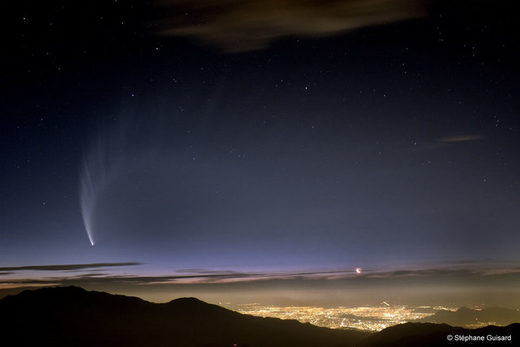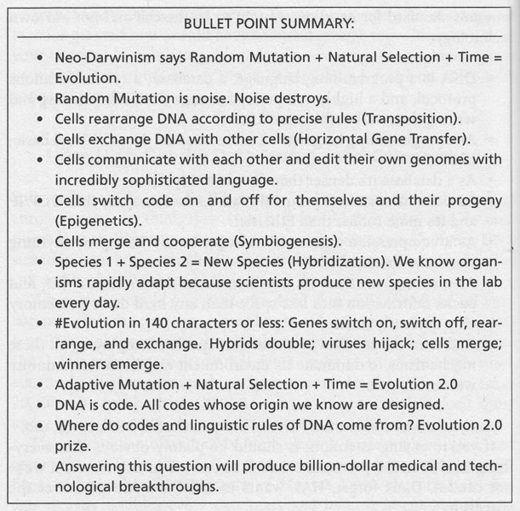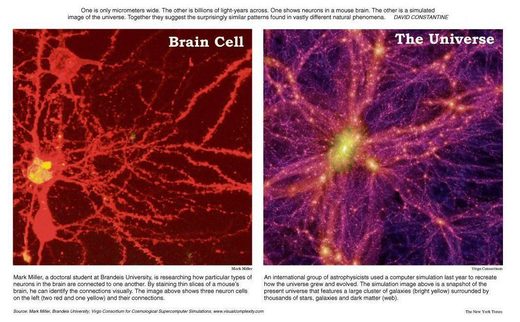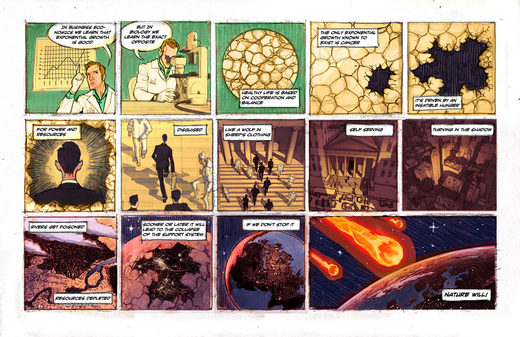
Fantastic! SOTT focusses on the amazing Fractal Universe. This idea of a “universal mind” has always appealed to me MH
As Above, So Below?
Flo Wagner
Sott.net
Tue, 14 May 2019 21:59 UTC

© Stéphane Guisard
Comet McNaught over Chile, January 2007Save Here is an old idea: our world is part of a living universe, with a mind of its own, a place that is not only a playground for indulging desires, but also a school for learning from the suffering generated by the struggle of existence. This idea lay at the heart of the ancient philosophy of Stoicism, established in Athens in the early 3rd century BC. In Comets And The Horns Of Moses, Laura Knight-Jadczyk summarized the Stoics’ basic philosophy thus:
“The world is rationally organised, and so explicable and understandable. The pattern is complete throughout. Within the organisation, different elements and parts are dynamic and governing, others are passive in function. The world is purposefully providential; so there is also a design as well as a pattern, and the good end is discoverable by the rational understanding of this. The divine element is completely and only immanent. As the system is an organic whole, the understanding of any part contributes to the understanding of the whole, and vice versa. Even the operation of any part is relevant to the operation of the whole. The operational law of cause and effect runs right through the behavior of phenomena and of living creatures. The understanding and explanation of its operation lies within, and only within, itself.”
When I read this, I was reminded of fractal patterns, a very common mathematical structure. Here is a selection of those patterns as they occur in nature:

“Fractals” in NatureThe Search For Intelligent Life
Modern science’s sober view of the universe pooh-poohs the notion of a ‘divine element’. It’s just an object of study – vast and mysterious, certainly, but ultimately just like any other object. If you expect to be taken seriously in ‘the scientific community’, you keep your amazement low key when you discover how brilliantly the Universe’s machinery is engineered. We are expected to believe that the highest forms of order – of which our civilization with all its technological marvels is just one small part – simply originate out of nothing: there is neither a plan involved, nor purpose, nor intelligence, they say. Just… BOOM!
How can that be?
From solar systems to animals, in Nature everything is functional and perfectly organized, allowing for some adaptability in response to dynamic changes, but otherwise following strict sets of rules. That it takes inherently structured form is alone a clear indicator of intelligence. But for the ‘serious’ scientist (who is invariably a neo-Darwinist, whether or not he is aware of it), that’s a ‘no-go’ area. Intelligence can only be ascribed to creatures like us, they say. Nature’s biological marvels only give the appearance of design but are simply the result of random mutation, “a happy chemical accident,” as the legendary atheist and evolutionary theorist Richard Dawkins put it.
Orderly structures created by Nature, no matter how sophisticated, are ‘only’ natural. If that is the case, what is so special about human beings? At what point does intelligence and consciousness enter the fray?
The Origin of Life
Despite the sophisticated heights science has reached, we remain incapable of reproducing life – certainly, not by any technological means. Mother Nature’s technology is far superior to our capabilities and comprehension. We didn’t invent life on Earth, she did. We just apply the little we learn from her in rather small, and generally not so brilliant, ways. Yet modern man tends to consider himself the only intelligent, and certainly the most sophisticated, life form. In our arrogance, we say, “mankind knows better,” while in reality every observation, every theory, every invention is Nature’s intellectual property.
In Evolution 2.0 – Breaking the Deadlock Between Darwin and Design, electrical engineer and information theorist Perry Marshall describes the struggle between two opposing camps: the Neo-Darwinists/Atheists on one side, who claim, Random Mutation + Natural Selection + Time = Evolution, and the advocates of Intelligent Design (along with the Creationists) on the other side, who claim ‘god’ created the universe and everything in it. Marshall concludes that Darwinists underestimate Nature, while Creationists underestimate God, and reminds us that it has already been established, in numerous ways, that DNA is literally code – a highly sophisticated one that exceeds every programming language we can conceive of.
The question is: where did this code come from? Random chance, the atheists claim. If so, where is the evidence for that? Marshall is offering $5,000,000 to the first person who can submit a purely chemical process that produces code.
Also taking aim at the case for random mutation is geneticist Theodosius Dobzhansky, who conducted extensive experiments that bombarded fruit flies with radiation for 30 years, inducing DNA mutations, which he – in line with the prevailing theory – expected would accelerate ‘evolution’ in the flies. But his experiments turned out to be highly detrimental to the fruit flies’ health. There is in fact no documented case, or application in any field of science, where noise/randomness adds information content – on the contrary, it disturbs and destroys information. In cases of evolutionary processes the evidence points to adaptive mutation. Imagine a damaged text on a page, where letters are missing: you rec_nstruct and fill in t_e g_ps.

© Perry Marshall
Bullet Point Summary from the Book ‘Evolution 2.0 – Breaking the Deadlock Between Darwin and Design’ From the Wikipedia entry on Rare Earth Hypothesis:
“In planetary astronomy and astrobiology, the Rare Earth Hypothesis argues that the origin of life and the evolution of biological complexity such as sexually reproducing, multicelluar organisms on Earth (and, subsequently, human intelligence) require an improbable combination of astrophysical and geological events and circumstances. According to the hypothesis, complex extraterrestial life is an improbable phenomenon and likely to be rare.”
If that were true, the occurrence of life on Earth must have been a bodacious coincidence, let alone the formation of the universe! Was life on Earth and the creation of the universe really just randomly occurring, happy accidents? Some scientists find the ‘leap of faith’ this requires too difficult to take. Biologist Dr. Rupert Sheldrake has said of the Big Bang theory: “As my friend Terrence McKenna used to say, ‘Modern science is based on the principle: give me one free miracle and we’ll explain the rest!‘” Many scientists literally believe that order miraculously emerges from nothingness.
So, if I do nothing, will order spontaneously emerge from my untidy living room? It sounds like they’re really saying: “We don’t know the cause, unless… but let’s not go there.”
Mind Over Matter
The word ‘matter’ derives from the Latin mater meaning ‘origin’, ‘source’, ‘mother’. The universe, in all its manifestations, is a well-designed, highly functional, holistic structure, and everything it gives birth to follows its rules – rules which scientists attempt to understand in order to gain knowledge. Like a child learns from its mother, scientists learn from matter. But is there only matter?
In philosophy, panpsychism is the view that consciousness, mind, or soul (psyche) is a universal and primordial feature of all things. Panpsychists like the ancient Stoics, Plato, Leibniz, William James or Alfred North Whitehead saw themselves as minds in a world of mind. The psychologist C.G. Jung, with his concept of the collective unconscious, was also of this mindset.
The young and curious human mind extrapolates intelligent explanations, scientific models, blueprints and mathematical rule sets, from nature’s super-old mind. This informs us about how things work, which makes us intelligent and enables us to further refine our pattern recognition abilities. The application of mathematical rules and concepts, which we as ‘intelligent beings’ supposedly developed on our own, have physical results in the material world, so it would seem that they existed long before mankind existed. But where exactly is the world of information – of mathematics and ideas – located, if not in our mind? Nature’s mind?
Our mind is strictly a material product of some as-yet-undiscovered brain function, goes the prevailing view. But scientists have been unable to pinpoint a biological location where memories are stored, while studies on rats have shown that, after teaching them a trick, no matter how much of their brain is subsequently cut away (until, of course, the rat dies), they still remember it. Is memory-retrieval thus a non-material phenomenon?
Matter, Energy and Information
Norbert Wiener, MIT’s legendary ‘father of cybernetics’ said:
“Information is information, neither matter nor energy. No materialism which does not admit this can survive at the present day.”
According to Tom Stonier, ‘father of information theory’, information is a fundamental constituent of the universe:
“Matter and energy comprise the surface of the universe. The surface structure of the universe is readily perceivable to our senses. The internal structure is more subtle. It’s organized in a manner not so obvious: it consists not only of matter and energy but of information as well.”
There seems to be a ‘pool’ or field of non-material information which informs matter, and guides it along established pathways, or ‘habits’ as Dr. Rupert Sheldrake puts it. Sheldrake proposed the theory of morphic resonance and morphic fields, which could explain many other strange phenomena – from precognition and swarm behavior to remote-viewing, to name a few. What if the mind or mental ‘center’ of creatures are essentially receivers of information from a vast, non-local and highly intelligent information field?
Holistic Systems
In this framework, there is no ‘dead matter’, but rather different levels of organisation, including life as one form. Although much more simply organized in comparison to living matter, what we call ‘inanimate matter’ also adapts and behaves in different ways under certain circumstances, undergoing chemical reactions and complex processes, and proceeding over unimaginably long periods of time.
Think of the formation of our planet, which took place long before it could sustain life. There was an evolution of ‘dead’ matter before that, forming the ‘metabolism’ of a star system. Consider how well-organized a planet must be to make life possible, and how fine-tuned weather and climate systems must be to regulate the subsequent existence of life. Where do we draw the line between ‘life’ and ‘death’?
Are galaxies alive? Do they communicate with each other? Cosmic phenomena have striking similarities to neuronal networks. As Stephen Smith from the Thunderbolts Project writes in ‘Electric Universe: Power Lines’:
Galaxies often exhibit alignment with one another across vast distances.
According to Electric Universe theory, galactic evolution occurs as large-scale plasma discharges form spinning wheels of coherent filaments that display electrodynamic behavior and not merely that which gravity alone can contribute. Stars in galaxies can also form long arcs that thread through them like silver beads on a string. No nebular contraction theory can adequately explain star formation. Beyond that, the great spirals that collect in clusters, that then also group themselves in superclusters, are beyond any conventional definition.
When plasma moves through a cloud of dust and gas, the cloud becomes ionized, initiating an electric field and the flow of electric current. Electricity moving through any substance forms magnetic fields that tend to align and constrict the current flow. Those fields create what are sometimes called “plasma ropes,” otherwise known as Birkeland currents.
Birkeland currents are electromagnetic filaments that carry electric charges through space. The filaments are double-walled, folded layers of charge separation, isolating regions of opposite charge and preventing them from neutralizing.
Almost every body in the Universe displays some kind of filamentation. Comet tails often occur in pairs. The dusty one forms an arc as it follows along its orbital path. The other one, composed of “stringy” ion filaments, reaches out from the nucleus in a straight line, always pointing away from the region of like polarity. Planetary nebulae are spun from intricate webs of lighted tendrils. Herbig-Haro stars and energetic galaxies emit braided jets. Some galaxies look “hairy,” with threads of material extending from them.
Since the various loads in galactic circuits radiate energy, they must be powered by coupling with larger circuits. How large those circuits are can be inferred by the observation that galaxies also occur in strings.
Everything seems to be connected: systems feeding systems, cycles within cycles, rules built upon rules. It’s as if all is part of one larger organism. Imagine an astronomer living on a planet that is actually an electron orbiting an atom, located within a molecule that is part of a cell cluster inside the guts of a fruit fly, who asks the same question…

[Click to enlarge]
A Human-Cosmic Connection
Proponents of man-made global warming believe the planet – specifically the biosphere – is undergoing radical change due to excessive human activity causing resource depletion and runaway levels of greenhouse gases. This, they posit, meddles catastrophically with the delicate climate controls that sustain life on Earth. If we would just (drastically) reduce our ‘carbon footprint’, eco-systems would survive, and humanity with them.
However, on the one hand they overestimate the physical impact human civilization has on systems that derive most of their energy and ‘informational content’ from the Sun, cosmic rays and other cosmic phenomena. On the other hand, they ignore the historical accounts of past (non-industrial, though highly organized) civilizations collapsing at times of great environmental upheaval.
Returning to the Stoic idea, Knight-Jadczyk wrote of one of the most important Stoics, Posidonius:
“Since the system is an organic whole and the operational law of cause and effect was a part of the system, it logically followed that the operation or state of any part could be relevant to the operation of the whole. This meant that forms of divination were valid means of scientific exploration, though certainly not in isolation. What followed from this was that, since it was possible to predict such things as tides from the position of the Moon, it should also be possible to predict the future behavior of other phenomena, including human events, from patterns and signs in the heavens and on Earth.
I don’t think that we need to assume that Posidonius took this to unreasonable lengths, as Augustine claimed, since the evidence that he was an ‘astrologer’ in the usual sense is just not there. But what seems to have been on his mind was the scientific exploration of signs and seasons, and trying and testing various methods of relating major events on the planet in the socio-political sphere to the cosmos at large and discovering their dynamic interaction.
In other words, as a rationalist who believed that a rational law permeated the universe, Posidonius inferred that all events follow an unbroken chain of causation, even if we, at the human level, cannot always see the cause for a specific effect. But, theoretically, the world should be rationally comprehensible if we study the world and all within it, and learn the patterns of cause and effect at one scale, and then apply them to other scales. Like a fractal, the cosmic patterns always follow through to real world events and we can follow the chain backward by way of scientific observations and analyses.
In Posidonius’ view, cosmic design was imposed rationally from the top down, but we can only partially reveal it and check the facts that will lead to understanding this design, from the bottom up.”
In the book Earth Changes and the Human-Cosmic Connection, engineer Pierre Lescaudron explored the ‘signs and seasons’ of our times – erroneously framed as ‘man-made climate change’ in modern science – in the context of historical episodes of civilizational collapse:
As depicted in Figure 202, far from our linear, uniformitarian vision of the universe, the ancient Chinese believed – and some continue to believe – that the behavior of rulers, the state of the world and natural catastrophes are intimately related. This was also the way our ancestors understood the world.

© Red Pill Press
Figure 202: The Chinese dynastic cycle
To give just one example of the correlation between cosmic disasters and leaders misconduct, we will focus on the last decades of the Roman Empire (530-580 AD). The following is an excerpt from Procopius’s Secret History, entitled ‘How Justinian Killed a Trillion People’. Keep in mind that Procopius was probably the most prominent historian of the 6th Century. Most scholars consider him the last major historian of the ancient world. Procopius was not only an historian; for more than ten years he was also a counselor to the greatest general of the time, Belisarius. As such, during this period of numerous travels, battles and negotiations, he was a direct witness of roman political and military life. After his retirement from military affairs, he became a judge and, in that capacity, he had the ways and means to obtain inside information that made up his Secret History.
“That Justinian was not a man, but a demon, as I have said, in human form, one might prove by considering the enormity of the evils he brought upon mankind. So while he was Emperor, the whole Earth ran red with the blood of nearly all the Romans and the barbarians. Furthermore the persecution of the Samaritans and the so-called heretics filled the Roman realm with blood. During his rule over the Romans, many disasters of various kinds occurred: which some said were due to the presence and artifices of the Devil, and others considered were effected by the Divinity, who, disgusted by the Roman Empire, had turned away from it and given the country up to the Old One.
The Scirtus River flooded Edessa, creating countless sufferings among the inhabitants, as I have elsewhere written. The Nile, rising as usual, but not subsiding in the customary season, brought terrible calamities to the people there, as I have also previously recounted. The Cydnus inundated Tarsus, covering almost the whole city for many days, and did not subside until it had done irreparable damage.
Earthquakes destroyed Antioch, the leading city of the East; Seleucia, which is situated nearby; and Anazarbus, most renowned city in Cilicia. Who could number those that perished in these metropoles? Yet one must add also those who lived in Ibora; in Amasea, the chief city of Pontus; in Polybotus in Phrygia, called Polymede by the Pisidians; in Lychnidus in Epirus; and in Corinth: all thickly inhabited cities from of old.All of these were destroyed by earthquakes during this time, with a loss of almost all their inhabitants. And then came theplague, which I have previously mentioned, killing half at least of those who had survived the earthquakes.
It seems that when a large enough number of people exhibit high levels of ignorance and false beliefs, cosmic turmoil soon follows; and if history is studied close and long enough, you’ll see the pattern emerge again, and again, and again. A negative feedback loop may develop at this point (bottom right of the above diagram). When natural catastrophes increase to the point that people finally realize that something is ‘up’, it also dawns on them that their leaders are unable to provide for their safety and so they turn against them. Social unrest grows and the elites turn to increasingly repressive measures of violence and control, which, in turn, increase the cosmic ‘reaction’, which further fuels the people’s anxiety and urge to revolt. Where do you think we are today on the ‘dynastic cycle’?
Although not consciously formulated, it strikes me as prescient that the ‘Yellow Vest’ revolt in France kicked off last November because of popular resistance to a planned increase in fuel tax, the ostensible reason for which was to reduce reliance on cars for transport while raising revenues for ‘fighting climate change’ and ‘saving the planet’. The increase in extreme and unseasonal weather in recent years has by now surely been noticed by most people, although visceral realization of what it portends is, for the most part, still missing. In the meantime, social unrest grows, and governments become increasingly totalitarian, which suggests we can expect even greater ‘cosmic reaction’ to come…
Cause And Effect
If the Universe itself is an organism with a mind of its own, then the same might apply to macro-systems like galaxies, solar systems, and so on down the scale, with the world ‘below’ manifesting much of the same patterns as the world ‘above’. All are subject to the principles of evolution and devolution: order and chaos, growth and decay, health and sickness. As with each living thing, on a long enough timescale, every macro-system is subject to entropy and eventually collapses, and until then it functions as a corrupted form of order.
Today’s elites pursue their drive for domination and control of other people and of all life. The emergent ‘postmodern’ manifestation of civilization they have birthed is civilization in a highly advanced state of corrupted order, a pathological (in)competence hierarchy. Predatory and warlike, yet effeminate and juvenile, it somehow continues to sustain large numbers of people, yet starves them of meaning and fundamental well-being thanks to an endless stream of infotainment masquerading as factual information.
The spiraling social unrest and extreme weather phenomena – among which I include the increase in comets and asteroids in near-Earth orbit – seem then to constitute an immune reaction to this macrosocial devolution, in part from the planet-as-organism, and in part from us, as one connected ‘super-organism’.

© Flow
[Click To Enlarge]That our civilization could be wiped out in the blink of an eye is a very real threat. Consider the Younger Dryas Impact hypothesis and the growing body of evidence supporting it: large comet fragments hit the North American Ice Cap at the end of the last ice age and caused cataclysmic flooding. If an advanced civilization existed back then, as some researchers suspect, there wouldn’t have been much of it left afterwards, which probably accounts for the ancient myths about a terrible deluge that brought civilization to its knees. Does history repeat? Or at least rhyme? Have we become so inured in our secular techno-specialness that we have forgotten just how unimportant we are from a cosmic perspective? And does human civilization need a little (or large) reminder of that from time to time?









Our mind is strictly a material product of some as-yet-undiscovered brain function, goes the prevailing view
A material product? Show me this material product then!
The prevailing view is not necessarily the correct one.
If a brain function is “as yet undiscovered” the prevailing view rests on a presumption of discovery. Sounds more like speculation than science to me.